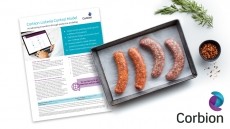EU researchers on track to produce vegetarian friendly ‘meat’ cutlets

The EU funded ‘LikeMeat’ project aims to produce an environmentally friendly meat replacement product from raw vegetable materials by taking seeds from plants and using them directly to produce protein that has the same textures and flavours as meat from animals.
The researchers – led by Florian Wild of the Fraunhofer Institute for Process Engineering and Packaging IVV, Germany – have now come up a prototype process that creates an endless piece of ‘meat’ that be shaped as desired.
“Our goal is to develop a vegetable surrogate for meat that is both juicy and fibrous, but that also has a pleasant flavour,” said Wild.
“As a group, we are seeking to engineer a simple production chain in which pure vegetable raw materials are used to produce a meat substitute that corresponds to consumer preferences," he explained – noting that the end product should also have a long shelf life, be suitable for vegetarians and allergy sufferers, and not be more expensive than meat.
New process
The prototype processing plant – currently located in the IVV lab – is said to be no larger than two table tennis tables, yet the unit can produce 60 to 70 kilos of the meat substitute per hour (300 to 500 kilos per day).
Wild explained that he and his colleagues use a new process that has been specially developed for meat substitutes.
Using the new process the main ingredients – water and plant proteins – are brought to a boil and slowly cooled down.
He explained that previous methods have used under high pressure, however this ‘proved to be useless’ because it lead to steam releases that caused the product to foam.
Since the new process involves no sudden release of pressure, no steam blows out of the paste, said Wild. Therefore, as the temperature lowers naturally, the protein molecules start to form chains – this gives rise to a fibrous structure that is quite similar to that of meat.
“Consistency and texture are already superb,” said Wild, who admitted that there is still ‘a little work’ to do on the flavour of the project.
However, by the end of the project, next year, he is confident that the meat substitute will taste just as good as a genuine meat cutlet – and will come directly from the machine, ready-to-eat.
Sustainable production
Meat production is complicated, explained Wild. It is costly to produce meat, and not eco-friendly, he said, noting that animals have to consume five to eight kilos of grain just to generate one kilogram of meat.
He argues that it would be simpler, and more sustainable, if we could make the ‘meat’ directly out of the seed – without the detour through an animal‘s body.
“Studies have shown that many Europeans are ready to give up meat, but there have only been a handful of alternatives until now,” said Wild.
The researcher explained that there are several plants that are suitable for the production of meat substitute products, including wheat, peas, lupin, and soya.
“We are intentionally not tying ourselves down to one type of plant because many people get an allergic reaction to the one or other substance,” he said.
“In the process, we have developed a variety of recipes. They are the basis for a product spectrum that offers a broad selection to people who suffer food intolerance or allergies.”























